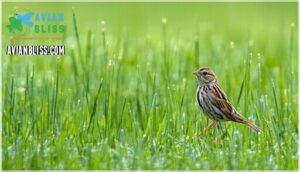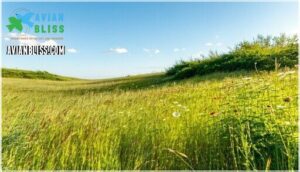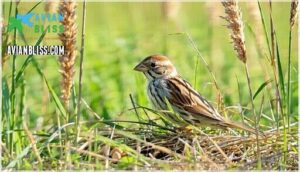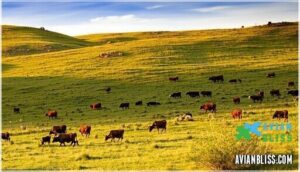This site is supported by our readers. We may earn a commission, at no cost to you, if you purchase through links.
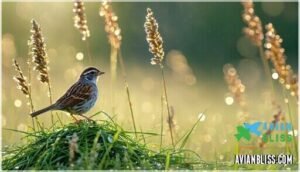
The species clings to specific tall grass meadows across the northeastern United States and eastern Canada, where its olive-green head, rusty wings, and distinctive hiccup-like song set it apart from common sparrows.
Habitat loss, intensive mowing during nesting season, and pesticide use continue to threaten this secretive bird, making identification and conservation knowledge essential for anyone who ventures into its remaining strongholds.
Understanding where to look, what features distinguish it from similar species, and how you can support recovery efforts gives you the tools to appreciate—and protect—one of our continent’s most vulnerable songbirds.
Table Of Contents
- Key Takeaways
- Henslow’s Sparrow Identification Guide
- Habitat Preferences and Geographic Range
- Behavior, Diet, and Vocalizations
- Conservation Status and Threats
- Conservation Actions and Management Strategies
- Frequently Asked Questions (FAQs)
- Why is the Henslow’s sparrow endangered?
- Where do Henslow’s Sparrows live?
- Who is the henslows sparrow named after?
- What are the nutrition habits of Henslows Sparrow?
- How does Henslows Sparrow adapt to seasonal changes?
- What predators threaten Henslows Sparrow populations?
- How does weather affect Henslows Sparrow migration?
- What are the unique features of juvenile Henslows Sparrows?
- How long do Henslows Sparrows typically live?
- Whats the average clutch size for nesting?
- Conclusion
Key Takeaways
- Henslow’s Sparrow has lost over half its population since 1975, making it one of North America’s most vulnerable grassland songbirds, with population declines driven by habitat loss, intensive mowing during nesting season, and pesticide use that eliminates its insect prey base.
- You can identify this secretive five-inch bird by its distinctive olive-green head, rusty wings with black streaking, flat-headed profile, and unique hiccup-like song that sounds like "tsi-lick," helping you distinguish it from similar grassland sparrows like Grasshopper or Le Conte’s Sparrows.
- The species requires very specific habitat conditions to survive—contiguous tallgrass prairies and meadows with dense vegetation, standing dead plant matter, and minimal woody plants—and won’t successfully breed in small, fragmented grassland patches.
- Conservation efforts that work include prescribed burning every 2-3 years to maintain open grassland, delayed mowing schedules that protect nests during breeding season, native grass planting programs, and landowner incentive programs that preserve suitable habitat across eastern North America.
Henslow’s Sparrow Identification Guide
Identifying Henslow’s Sparrow in the field can be tricky, but a few key features make it stand out from other grassland birds.
You’ll want to focus on size, coloring, and markings to confirm what you’re seeing. Let’s break down the characteristics that help you tell this sparrow apart from its look-alikes.
Physical Characteristics
At just five inches long, Henslow’s Sparrow packs a surprising amount of visual detail into its compact, flat-headed frame. You’ll notice its olive-green head wash contrasts beautifully with rusty brown wings and back.
The bird’s plumage features sharp black streaks across a whitish chest, while its short, pointed tail completes the profile. Size dimorphism isn’t obvious between males and females, making Henslow’s Sparrow identification rely heavily on these unique markings rather than gender differences.
Distinguishing Features
While those physical traits paint a clear picture, you’ll want to lock onto a few standout field marks that separate this sparrow from its grassland cousins. Look for the flat-headed profile and olive-green head wash—key elements in any Henslow’s Sparrow identification.
The rusty back with black streaking creates a distinctive pattern you won’t confuse with other species. Pay attention to tail morphology: it’s short and somewhat pointed, giving the bird a compact silhouette that’s unmistakable in bird identification contexts.
Juvenile Vs. Adult Identification
Spotting the difference between a young Henslow’s Sparrow and its adult counterpart takes a sharp eye, since the juvenile plumage shares many of the same markings but with softer, less defined streaking. Here’s what to watch for in your field guide observations:
- Plumage differences: Juveniles show buffier underparts with fainter breast streaking compared to adults’ sharper contrasts.
- Molting patterns: Young birds undergo their first prebasic molt in late summer, gradually acquiring adult-like bird plumage.
- Size variation: Fledglings appear slightly smaller and more compact initially.
- Behavioral cues: Juveniles stay close to vegetation, moving hesitantly while adults forage more confidently.
- Vocal development: Young birds produce softer, incomplete versions of the adult’s distinctive tsi-lick call.
Similar Species Comparison
Once you’ve mastered aging Henslow’s Sparrows, you’ll want to sharpen your skills at separating them from other small grassland birds that share their secretive habits and streaky plumage. This bird identification guide helps you distinguish Henslow’s from similar sparrows using key field marks.
| Species | Key Differences | Habitat Overlap |
|---|---|---|
| Grasshopper Sparrow | Clear breast, orange face, lacks Henslow’s greenish nape | High in dry grasslands |
| Le Conte’s Sparrow | Bright orange eyebrow and face, white crown stripe | Wet meadows and marshes |
| Baird’s Sparrow | Orange-buff face, bold necklace of streaks across chest | Western prairies only |
| Field Sparrow | Pink bill, plain breast, lacks streaking entirely | Brushy edges, not deep grass |
| Sharp-tailed Sparrow | Gray face, coastal marshes, stronger facial pattern | Salt and freshwater marshes |
Your Henslow’s Sparrow identification relies on spotting that distinctive flat-headed profile, olive nape, and those fine dark streaks on the sides—features no other grassland sparrow combines quite the same way.
Habitat Preferences and Geographic Range
Understanding where Henslow’s Sparrow lives and travels helps you know where to look for this elusive bird. The species has specific needs regarding grassland habitats, and its range has shifted over the years.
Let’s explore the breeding grounds, migration routes, regional populations, and habitat requirements that define this sparrow’s relationship with the landscape.
Breeding and Wintering Grounds
Henslow’s Sparrow follows a fairly predictable split between its summer and winter homes, breeding in the grasslands of the northeastern United States and parts of eastern Canada before heading south to spend the colder months in the Gulf states.
During the breeding season, you’ll find them nesting in tall grass meadows where habitat connectivity aids their ground fidelity. When migration kicks in, they shift to weedy fields across Florida and the Southeast, where winter survival depends on finding suitable grassland habitat with dense cover for foraging.
Migration Patterns and Timing
Starting in mid-March, you’ll notice these short-distance migrants begin their journey north from Gulf Coast wintering grounds, with arrivals at breeding sites by mid-May as grassland "green-up" occurs. Migration patterns and timing align closely with climate influence and temperature shifts. Fall migration distance is brief—birds depart July through October, reaching winter sites by November.
Site fidelity is strong, with over 75% returning within 200 meters of previous locations. Migration corridors remain poorly understood, though habitat connectivity and survey period data suggest birds favor established pathways along the mid-Atlantic during both spring and fall movements.
The species is listed as an endangered species under the Species at Risk Act.
Regional Populations (Kansas, New York, Etc.)
Across regional variations, you’ll find Kansas populations remain somewhat stable—Konza Prairie holds the state’s largest concentration. New York trends show continuing declines, reflecting broader species status and rank concerns.
Geographic distribution and occurrences reveal Henslows Sparrow populations vary dramatically by habitat connectivity and local management. Genetic diversity studies suggest distinct population segments, though regional data remains limited for thorough species distribution analysis.
The sparrow is considered a grassland obligate species, needing specific habitat for breeding.
Grassland and Meadow Habitat Requirements
You might think any patch of tall grass will do, but Henslow’s Sparrow actually needs a very specific mix of features to call a place home. Look for contiguous grassland with dense vegetation—think waist-high grasses mixed with standing dead plant matter.
Patch size matters too; small, fragmented meadows won’t support breeding.
Management practices like prescribed burning help maintain the grassland composition these sparrows prefer.
Behavior, Diet, and Vocalizations
If you’ve ever wondered what Henslow’s Sparrow does when no one’s watching, you’re in the right place. This secretive bird has some quirky habits, from its ground-level foraging style to its unique, hiccup-like song.
Let’s break down how this sparrow feeds, communicates, and goes about finding a mate.
Foraging Habits and Diet Composition
Like a detective working the ground with methodical patience, this sparrow spends most of its time foraging alone through dense grass and weeds, searching for its next meal. You’ll find it hunting for insects and invertebrates, particularly during breeding season when these dietary energy sources fuel nesting efforts. Seasonal diet shifts occur as winter approaches, with seeds from grasses and sedges becoming more important.
Its prey base includes:
- Grasshoppers and crickets from the ground layer
- Beetles and caterpillars hidden in vegetation
- Ants and other small invertebrates
- Grass and sedge seeds during non-nesting periods
This ground foraging behavior keeps the bird well-hidden in its preferred foraging habitat specifics.
Song and Call Description
If you’ve ever tried to catch a hiccup in a bottle, you’ll understand the challenge of hearing Henslow’s Sparrow’s song—it’s one of the shortest, most explosive vocalizations in the grassland bird world. The insectlike song sounds like a hiccup or sneeze: a sharp, two-note tsi-lick that lasts barely a second.
Acoustic analysis reveals little variation in this bird song across its range, with minimal regional dialects documented, making vocal development studies particularly straightforward compared to other sparrow species.
Mating and Territorial Behaviors
Male Henslow’s Sparrows don’t defend large territories the way many songbirds do—instead, they claim small singing posts within loosely organized breeding colonies, where several males may nest surprisingly close together in the same field. Territory defense focuses on these immediate perches rather than expansive areas.
Males use their distinctive bird song during courtship rituals to attract females for mate selection and pair bonding. You’ll notice vocalizations intensify as males establish nest site preferences, with Henslows Sparrow behavior centering on these compact breeding zones where nesting and breeding habits unfold in surprising proximity to neighboring pairs.
Courtship Displays and Nesting Behavior
Once a female accepts a male’s invitation, the pair moves quickly to nest construction, with the female doing most of the work weaving together a cup-shaped structure hidden at the base of a grass clump or within dense vegetation just inches above the ground. She lines the nest with fine grasses and sometimes animal hair, creating a secure cradle for her eggs.
Henslow’s Sparrow nesting behavior includes:
- Clutch size usually ranges from 3 to 5 eggs per breeding attempt
- Nest construction takes several days, with materials gathered from the immediate area
- Parental care focuses heavily on the female during incubation, roughly 11 days
- Nest success depends on avoiding predators and maintaining dense ground cover
- Courtship displays remain minimal compared to other sparrows, emphasizing vocal rather than visual signals
Conservation Status and Threats
Henslow’s Sparrow isn’t doing well across most of its range, and understanding why can help you appreciate what this bird needs to survive. Several key threats have pushed its numbers down over the years, from disappearing grasslands to changing weather patterns.
Let’s look at the main challenges this little sparrow faces today.
Population Trends and Decline
Over the past fifty years, Henslow’s Sparrow has lost more than half its population, though recent conservation efforts show stabilization in some areas. Survey-wide data reveals a 1.5% annual decline, with range shifts particularly affecting northern populations.
Kansas populations at sites like Konza Prairie remain critical for Henslow’s Sparrow conservation. Genetic diversity and extinction risk assessments through population modeling guide ongoing conservation status evaluations and efforts.
| Region | Population Trend |
|---|---|
| Northern Range | Severe decline (18.7% annually in New York) |
| Southern States | Slight increases from habitat programs |
| Kansas | Stable at protected sites |
| Overall Range | 50%+ loss since 1975 |
Habitat Loss and Fragmentation
The population decline you’ve just seen stems directly from widespread habitat loss and fragmentation across the sparrow’s range. More than 90% of native grasslands in midwestern and eastern North America have disappeared, converted to cropland or swallowed by urban sprawl.
Fire suppression allows woody plants to invade grasslands, shrinking suitable breeding areas further. Fragmented patches suffer from edge effects that reduce nest success and survival rates. Patch size matters greatly—detection probability hits 50% only in grassland fragments exceeding 55 hectares.
Without habitat connectivity, isolated populations face local extirpation. CRP enrollment helped stabilize some declines, but when contiguous grassland becomes scattered fragments, conservation efforts struggle to maintain viable populations.
Agricultural and Land Use Impacts
Modern farming practices have reshaped the landscape in ways that go far beyond what fragmentation alone can explain, turning potential breeding grounds into ecological dead zones for Henslow’s Sparrow. Intensive hay mowing during nesting season destroys clutches outright, while pesticide use decimates the insect prey base these birds depend on.
Early and frequent mowing prevents successful fledging, and insecticide applications leave grasslands barren of crickets and beetles essential for chick survival.
Climate Change Effects
As shifting weather patterns intensify across grassland ecosystems, Henslow’s Sparrow faces escalating threats that compound existing challenges like habitat fragmentation and disrupted fire regimes, further jeopardizing its survival. Climate change poses risks to this endangered species through multiple interconnected pathways:
- Breeding seasonality disruptions: Spring rainfall variability increases fledgling success up to 35% in wet years, but extreme heat causes nest failure rates exceeding 40%.
- Range shifts: Wintering grounds have moved 60 km southward in the Carolinas since 1995, while northwestern breeding edges have contracted by 12% since 2000.
- Population volatility: Annual survival rates plummeted to 40% in climate-affected sites, with fledgling production down by 50% during unusually hot summers.
- Migration timing: Arrival dates now fluctuate by over 10 days compared to historical patterns, shortening breeding windows by 15–22%.
- Habitat availability: Extended droughts have reduced suitable territories by 28% over the past decade, with models projecting 20–30% fewer successful breeding attempts by 2050.
Conservation Actions and Management Strategies
Saving Henslow’s Sparrow isn’t just about observing—it requires hands-on work in the field. You’ll need to focus on four main strategies that work together to protect this vanishing bird.
Each approach plays a unique role in giving these sparrows the grassland homes they desperately need.
Habitat Restoration and Management
You can’t bring back a bird without first bringing back the ground it needs to survive, and for Henslow’s Sparrow, that means restoring and managing the grasslands that have nearly vanished across much of eastern North America.
Grassland restoration involves careful vegetation management, invasive control, and sustainable agriculture practices that rebuild habitat connectivity across fragmented landscapes.
| Management Practice | Conservation Benefit |
|---|---|
| Prescribed burns | Removes woody plants, maintains open grassland ecosystem |
| Native grass planting | Creates suitable breeding habitat structure |
| Invasive species removal | Restores grassland health and diversity |
| Delayed mowing schedules | Protects nests during breeding season |
| Wetland creation | Provides additional foraging areas nearby |
Monitoring and Research Initiatives
Scientists track Henslow’s Sparrow through long-term population surveys like the North American Breeding Bird Survey, which monitors over 170 routes across 17 states to assess trends and conservation impact.
Modern tracking technologies, including Motus telemetry systems, reveal migration patterns and habitat use by detecting tagged birds up to 30 miles away.
Ecological surveys and monitoring efforts also involve public engagement through citizen-science projects, where volunteers contribute nest observations and field data that strengthen research initiatives nationwide.
Prescribed Burning and Vegetation Management
Prescribed burning acts like a reset button for grasslands, clearing away dense vegetation and woody plants that would otherwise crowd out the sparse, weedy habitat Henslow’s Sparrows need to thrive.
Effective grassland ecosystem management strategies include:
- Burn timing during dormant seasons to minimize nest disturbance
- Fire frequency every 2-3 years for habitat patchiness
- Rotational burn regimes across multiple fields
- Grazing management combined with prescribed burning for habitat
- Invasive control targeting woody encroachment
These vegetation management strategies create the mosaic of open areas and standing dead stems that support this declining species.
Community and Policy Involvement
Saving Henslow’s Sparrow isn’t just a job for biologists in knee-high boots—it’s a team effort that stretches from landowners and farmers to lawmakers and local conservation groups, all working together to keep suitable grasslands on the landscape.
Landowner programs offer incentives for habitat preservation, while Wildlife Action Plans guide species protection across states. Citizen science projects boost public awareness, and local advocacy pushes policy impacts that support conservation of endangered species.
| Action | Who’s Involved |
|---|---|
| Habitat preservation grants | Landowners, NRCS |
| Conservation actions planning | State wildlife agencies |
| Species monitoring | Citizen science volunteers |
| Policy development | Lawmakers, advocacy groups |
| Education outreach | Local conservation groups |
Frequently Asked Questions (FAQs)
Why is the Henslow’s sparrow endangered?
Habitat degradation stands as the primary threat, though it’s not the only villain in this story. Agricultural intensification, pesticide effects on their prey base, and contiguous grassland requirements vanishing through population fragmentation have pushed Henslow’s Sparrow populations downward, compounded by climate change threats.
Where do Henslow’s Sparrows live?
Henslow’s Sparrows need contiguous grassland with thick vegetation, standing dead weeds, and minimal woody plants.
You’ll find them in tallgrass prairies, wet meadows, and old fields across eastern North America, though habitat fragmentation and urban encroachment have sharply reduced their range.
Who is the henslows sparrow named after?
This sparrow honors John Stevens Henslow, a British botanist and clergyman who mentored Charles Darwin.
Audubon named the species Centronyx henslowii in 1829, recognizing Henslow’s contributions to natural history and his Passerellidae family connection.
What are the nutrition habits of Henslows Sparrow?
During warm months, crickets and grasshoppers make up most meals, while cold weather shifts priorities toward weed and grass seeds scattered across open ground.
You’ll find them foraging low, picking insects from stems or scratching through leaf litter.
How does Henslows Sparrow adapt to seasonal changes?
As seasons shift, this sparrow adjusts through migration triggers and breeding cycles. Diet changes from insects during breeding season to seeds in winter, while molting patterns and thermoregulation help manage temperature extremes affecting foraging behavior.
What predators threaten Henslows Sparrow populations?
Every bird faces danger, but ground-nesters like Henslow’s Sparrows are especially vulnerable. Nest predation by snakes, raccoons, and skunks poses major threats to wildlife.
Fledgling vulnerability increases risks from mammalian predators and raptors, making predator management essential for Henslow’s Sparrow conservation and endangered species protection.
How does weather affect Henslows Sparrow migration?
Temperature influence and precipitation effects shape your bird’s journey, as storms trigger early departures from breeding grounds.
Wind patterns guide them south, while climate change disrupts traditional timing, forcing adaptations in eastern North America’s grasslands.
What are the unique features of juvenile Henslows Sparrows?
Like spotting a needle in a haystack, juvenile Henslow’s Sparrows can be tricky to identify. Their juvenile plumage shows buffier tones with less distinct streaking than adults.
Their vocal development progresses gradually under parental care as nestlings grow on a protein-rich diet.
How long do Henslows Sparrows typically live?
While exact data remains scarce for this avian species, most small grassland bird species live 2-4 years in the wild.
Average Longevity depends on Lifespan Factors like predation and habitat quality, with Maximum Age rarely documented in Henslows Sparrow conservation studies.
Whats the average clutch size for nesting?
You’ll usually find three to five eggs tucked in their nests, with four being most common during breeding season. Clutch size factors include nesting success rates and parental care duration.
Females manage the incubation period of about eleven days solo before both parents share feeding duties.
Conclusion
These grassland specialists won’t disappear quietly—they’re just slipping away one mowed field at a time. Your ability to recognize a Henslow’s sparrow by its olive head, rusty wings, and hiccup song transforms you into a frontline observer for conservation efforts.
Support habitat restoration on private lands, advocate for delayed mowing schedules during breeding season, and report sightings to local ornithological societies.
Every observation you record contributes data that shapes management decisions, turning casual birdwatching into meaningful conservation action for one of North America’s most vulnerable songbirds.
- http://www.kaufmanfieldguides.com/
- https://widnr.widen.net/content/orciig8474/original/WWAP_AssociationScore_Spreadsheet.xlsx?u=kkadwx&download=true
- https://dnr.wi.gov/topic/wildlifehabitat/actionPlanActions.html
- https://partnersinflight.org/wp-content/uploads/2017/03/PIF-Henslows-Sparrow-Status-Assessment.pdf
- https://journal.afonet.org/vol93/iss1/art9/JFO-2022-77.pdf


